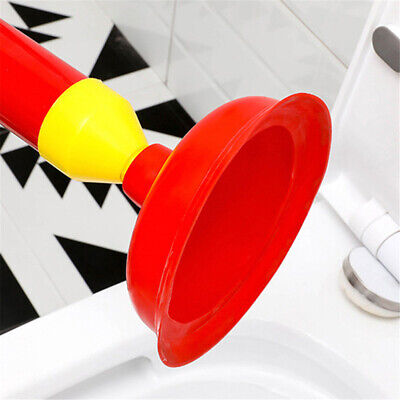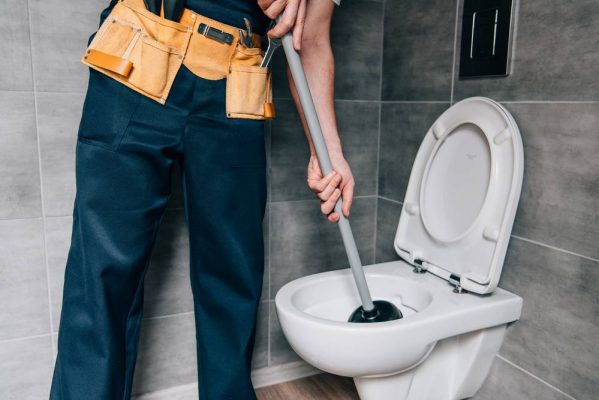Utilizing Plunger and Drain Cleaner: Effective Strategies
Utilizing Plunger and Drain Cleaner: Effective Strategies
Blog Article
Just how do you really feel when it comes to Here's How to Correctly Use a Toilet Plunger?

Intro
Proper maintenance of house drains is necessary for preventing blockages and making certain smooth water flow. One of the secret devices in every homeowner's toolkit is the plunger, together with numerous drainpipe cleansers developed to tackle stubborn clogs effectively. This write-up explores how to utilize plungers and drainpipe cleaners efficiently to keep your drains pipes streaming freely.
Section 1: Recognizing Bettors
Sorts of Plungers
There are numerous kinds of plungers available, each designed for various kinds of drains and clogs. The most common kinds consist of mug plungers, flange bettors, and accordion plungers.
How Plungers Job
Plungers service the principle of developing stress and suction to dislodge obstructions. When effectively applied over a drain, they create a vacuum that can take out debris or separate blockages.
Picking the Right Bettor
Choosing the ideal plunger depends upon the sort of drain and the nature of the clog. Cup bettors are suitable for sinks and bathtubs, while flange plungers are better suited for toilets due to their layout.
Typical Blunders with Bettors
Avoiding these errors makes sure reliable plunging: inappropriate seal around the drainpipe, not enough pressure, and unclear surrounding particles.
Area 2: Making Use Of Plungers Efficiently
Preparation
Prior to plunging, guarantee the bettor covers the drainpipe totally and develops a limited seal. Clear any noticeable particles around the drainpipe opening.
Method
Beginning with mild plunging motions to build suction. Increase stress gradually, utilizing a stable rhythm. Repeat as required up until the drain removes.
Repairing Tips
If plunging does not function, attempt readjusting the seal, applying oil jelly for a far better seal, or utilizing a different type of bettor.
Area 3: Comprehending Drain Cleansers
Types of Drainpipe Cleansers
Drain pipes cleansers can be chemical or enzymatic. Chemical cleansers utilize strong chemicals to liquify obstructions, while chemical cleansers utilize all-natural enzymes to break down raw material.
Just How Drainpipe Cleaning Company Job
Chemical cleansers react with obstructions to liquify them, while chemical cleaners break down natural materials like hair and grease without harming pipelines.
Safety Factors to consider
Always wear gloves and eye security when making use of chemical drain cleaners. Ensure sufficient ventilation and follow producer guidelines thoroughly.
Eco-Friendly Alternatives
Take into consideration utilizing vinegar and baking soda or enzyme-based cleansers for eco-friendly options that are more secure for pipelines and the environment.
Section 4: Using Drainpipe Cleaners Properly
Application Strategies
Pour chemical cleaners straight into the drain opening. Permit them to work for the suggested time before purging with hot water. Chemical cleansers ought to rest overnight.
Precautions
Avoid blending various kinds of cleaners, as this can produce toxic fumes. Never ever utilize chemical cleaners in conjunction with a bettor, as splashing can take place.
Dealing With Persistent Blockages
For persistent clogs, take into consideration making use of a plumbing snake or calling an expert plumbing technician to stop damages to pipelines.
Verdict
To conclude, comprehending exactly how to make use of bettors and drainpipe cleaners successfully is essential for maintaining healthy and balanced plumbing systems. By selecting the right devices and strategies, property owners can tackle minor blockages and avoid major pipes problems down the line.
How to Use a Plunger to Unclog a Drain
The humble plunger is a simple yet effective tool for breaking clogs in sinks, tubs and toilets. This handy tool is easy to use. You can make the most of its power if you understand how it works. Ready to dive in? Here’s what you need to know.
Safety First!
Never use a plunger with drain chemicals. Water will splash as you work, and the chemicals can spatter, burning skin and eyes. It’s a good idea to use rubber gloves and wear safety goggles when you work on a clog.
Choose the Right Tool for the Job
Plungers come in two different styles. Sinks, bathtubs and showers require a cup plunger. Like its name suggests, the rubber end is shaped like a cup. Use a flange plunger on toilets. These plungers have a rubber funnel extending from the cup. A plunger needs to be big enough to cover the drain.
Ready, Set, Plunge!
Coat the rim: Coat the plunger rim with petroleum jelly. This helps make a better seal.
Block outlets: Hold a wet rag over nearby outlets such as the overflow vent or the drain in a second sink.
Release air: Insert the plunger at an angle into the water. Water will displace air in the cup. A water-filled cup is more forceful than one filled with air.
Keep the plunger upright: Hold the plunger perpendicular to the drain. Use fast, forceful strokes, but make the first stroke gentle. The first stroke can create a splash if the cup still contains air. Thrust the plunger 15 to 20 times.
Snap off the plunger: The final stroke should be a strong upward motion that ends when the plunger snaps off the drain.
Repeat the process: you may need to repeat this sequence several times. When the water drains away, your work is done. High-five! https://plumbernw.com/blog/how-to-use-a-plunger-to-unclog-a-drain/

Application Strategies
Pour chemical cleaners straight into the drain opening. Permit them to work for the suggested time before purging with hot water. Chemical cleansers ought to rest overnight.
Precautions
Avoid blending various kinds of cleaners, as this can produce toxic fumes. Never ever utilize chemical cleaners in conjunction with a bettor, as splashing can take place.
Dealing With Persistent Blockages
For persistent clogs, take into consideration making use of a plumbing snake or calling an expert plumbing technician to stop damages to pipelines.
Verdict
To conclude, comprehending exactly how to make use of bettors and drainpipe cleaners successfully is essential for maintaining healthy and balanced plumbing systems. By selecting the right devices and strategies, property owners can tackle minor blockages and avoid major pipes problems down the line.
How to Use a Plunger to Unclog a Drain
The humble plunger is a simple yet effective tool for breaking clogs in sinks, tubs and toilets. This handy tool is easy to use. You can make the most of its power if you understand how it works. Ready to dive in? Here’s what you need to know.
Safety First!
Never use a plunger with drain chemicals. Water will splash as you work, and the chemicals can spatter, burning skin and eyes. It’s a good idea to use rubber gloves and wear safety goggles when you work on a clog.
Choose the Right Tool for the Job
Plungers come in two different styles. Sinks, bathtubs and showers require a cup plunger. Like its name suggests, the rubber end is shaped like a cup. Use a flange plunger on toilets. These plungers have a rubber funnel extending from the cup. A plunger needs to be big enough to cover the drain.
Ready, Set, Plunge!
Coat the rim: Coat the plunger rim with petroleum jelly. This helps make a better seal. Block outlets: Hold a wet rag over nearby outlets such as the overflow vent or the drain in a second sink. Release air: Insert the plunger at an angle into the water. Water will displace air in the cup. A water-filled cup is more forceful than one filled with air. Keep the plunger upright: Hold the plunger perpendicular to the drain. Use fast, forceful strokes, but make the first stroke gentle. The first stroke can create a splash if the cup still contains air. Thrust the plunger 15 to 20 times. Snap off the plunger: The final stroke should be a strong upward motion that ends when the plunger snaps off the drain. Repeat the process: you may need to repeat this sequence several times. When the water drains away, your work is done. High-five! https://plumbernw.com/blog/how-to-use-a-plunger-to-unclog-a-drain/

As an enthusiastic reader on How to Use a Plunger to Unclog a Toilet or Drain, I imagined sharing that chunk was a great idea. Sharing is good. Helping others is fun. I thank you for your readership.
Or Book Technician Here Report this page